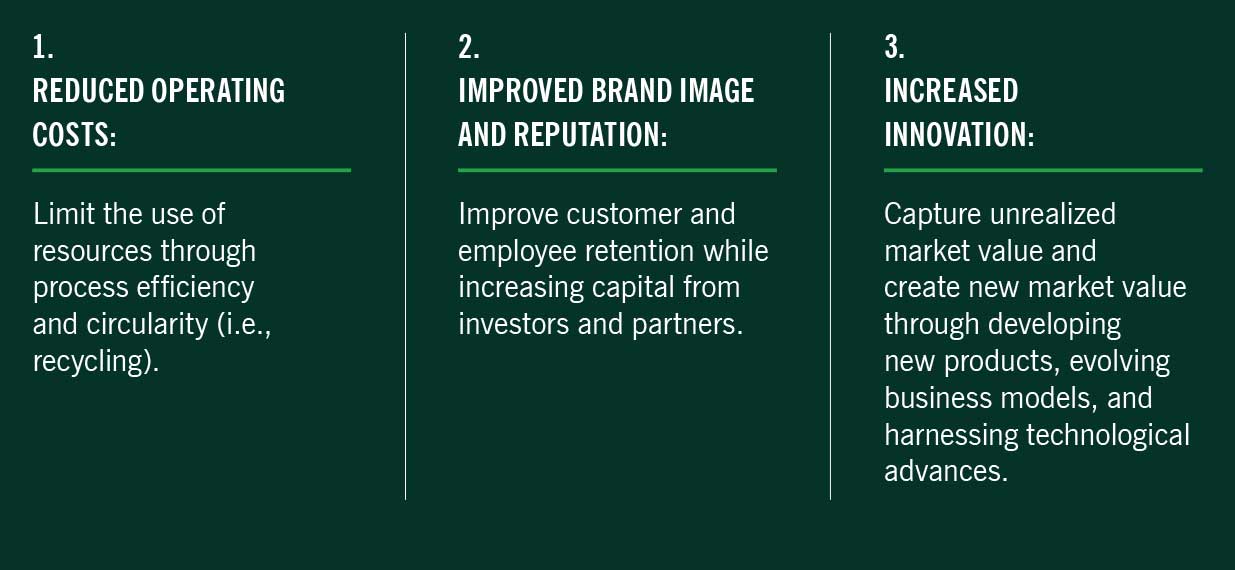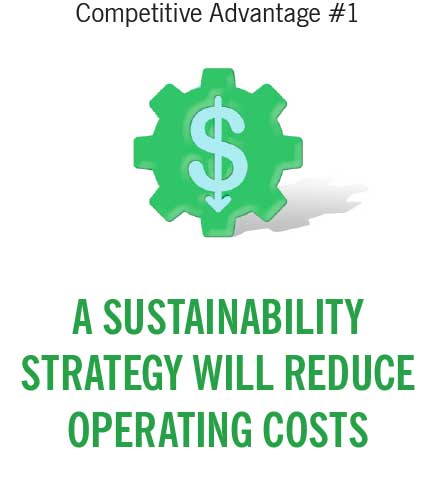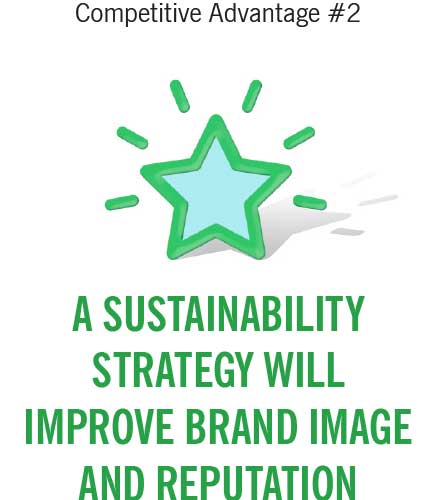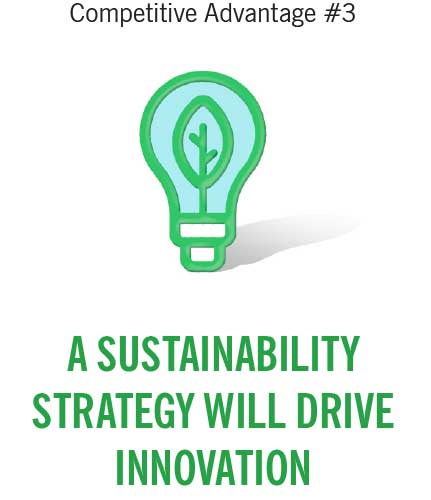The latest projections signal a potential global temperature increase of 2.7C (4.9F) by 2050, setting the stage for extreme heat, widespread flooding, and drought, which all loom forebodingly in our future. This new world image would not only impact how and where we live but also how we do business, and no organization is exempt from doing its part and taking action to pave the way to a better future.
As a society, we must recognize our role and influence in the environment and adapt our ways. We must use business as a tool for sustainable change. However, to effectively achieve this collective benefit, a return for all stakeholders must be realized. Companies should focus on a long-term competitive horizon — 2030 and 2050 — to establish resilient practices to become sustainable enterprises. The pathways are many, but should address and include ways the company can use its sustainability strategy to drive the following competitive advantages for itself, typically in this order:


When considering the advantages of a corporate sustainability strategy, your mind may immediately think of qualitative benefits like greater corporate social responsibility, improved public image, and perhaps better recruiting. While your company should realize perks such as these through investing in sustainability, you may be surprised to hear that sustainability will also drive your organization to save money.
As companies react to an uncertain economic landscape and continue to meet changing consumer demands, cost reduction may be one of the topmost strategic priorities for your organization. Luckily, a company with sustainability core to its enterprise strategy will readily find opportunities to reduce costs and generate savings, including through the following actions:
Find ways to do more with less (or with the same). A powerful and fruitful sustainability strategy should focus on delivering energy savings and improving supply chain efficiency. Imagine yourself in the following scenarios:
Energy Efficiency: You’re a retail company with a massive real estate and facility footprint and facing rising energy costs. You decide to invest in energy-efficient lighting and HVAC systems. Over the coming months, you begin to realize the benefits as your energy usage declines and you begin noticing your daily, weekly, and monthly store profitability increasing through these energy savings. You have also extended the lifespan of your lighting fixtures, thus reducing purchasing frequency.
Recycled Materials in Supply Chain: You are an industrial and consumer products company. You start to use recycled materials within your supply chain to reduce direct material costs. In addition to the reduced costs, you may be surprised to find that your product quality and brand image improved, allowing you to take advantage of premium pricing opportunities and increase your gross margin.
Change How You Operate: After making changes within your existing operations, adjusting your value chain presents additional opportunities for cost savings:
Reduce Waste (or Sell It!): If you commit to reducing the waste produced from doing business, you can realize cost savings for waste management services across your value chain. There can be significant savings, especially for companies in high-waste industries such as manufacturing and construction. As a further commitment to a sustainable world, you later may find opportunities for selling waste and promoting the reuse of unwanted materials.
Optimize Packaging: Consider your products’ packaging. It may utilize thick or unnecessary plastics or unrecyclable materials. A reduction in packaging materials can provide significant cost savings when these savings are extrapolated across your entire inventory of units sold.
This discussion is not without consideration of the tradeoffs. In the past, we’ve helped clients establish assessment criteria for retail store evaluations. In doing so, “energy efficiency” is often considered as a potential criterion. However, there are certain retail stores that, on a hot summer afternoon, will keep the front doors open, blasting air conditioning to attract passing potential customers into the store. Simple scenarios like these may prevent some companies from considering energy efficiency to be a high-priority area. However, as a company establishes and integrates its sustainability strategy across its business operations, taking a hard look at common practices will help identify cost savings opportunities.
Through the execution of a sustainability strategy, companies can make value chains sustainable, increasing the use of clean energy, catalyzing the quest for circularity, and localizing supply chains, therefore boosting economic development in and around the communities they serve. While these are all potential hard cost savings, integration of sustainability into your corporate strategy can also lower costs associated with customer attraction, talent acquisition, and employee retention. Effectively communicating the impacts of your efforts to internal and external stakeholders will be paramount as consumer behavior continues to shift to support a more sustainable future.

Delivering a robust sustainability strategy confers business reputational advantages, providing a key competitive edge. Leaders who embrace a culture of meaningful sustainability practices see advantages in attracting and retaining customers, employees, investors, and partners.1,2,3,4 This advantage derives from two primary sources:
1. Intrinsic motivation: These individuals value sustainability and want to see their employer, partners, vendors, and investors embrace similar values.
2. Extrinsic motivation: These individuals gain something directly from working with sustainable businesses, such as the ability to reduce their own carbon footprint by minimizing Scope 3 emissions or the ability to market an ESG-focused fund to hungry investors.
Regardless of the motivation, the impact is the same — people want to work with and for companies that take sustainability seriously. This is partly why many organizations have worked hard to be seen as ESG leaders, but also why some have been tempted to exaggerate their results. Greenwashing — the practice of exaggerating the value and impact of an organization’s environmental practices, programs, and outcomes — has presented such significant advantages that some leaders have been willing to accept the potential risks of such fraud, including legal liability, to reap the potential rewards.5
Unfortunately for scrupulous businesses, the greenwashing practices of some companies have attracted the attention of government regulators, market participants, and investors, leading to a rise in calls for additional regulatory requirements and scrutiny for businesses6 and investment funds7 of all stripes.
Organizations that are already engaged in authentic sustainability will be well-positioned once this happens. Not only are they best positioned to avoid potential penalties and draconian oversight stemming from failing to adhere to sustainability regulations, but businesses that already meet or exceed regulatory requirements also stand to be rewarded by the market and public, who will see this as evidence of those organizations’ credibility in the space.
For this reason, sustainability can no longer simply be a few nice words in a marketing campaign. Meaningful sustainability programs that result in measurable improvements to an organization’s reputation for environmental, economic, and social sustainability will play an increasingly important role in ensuring favorable business outcomes.

The pathway to a brighter future is through sustainable value innovation. As Peter Diamandis put it, “In a rapidly changing world, prevention might be the key to defeating existential risk, but adaptability and agility are the ultimate measures of prevention.” The cost of inaction is far greater than making the pertinent investments now. Failing to act could leave business leaders flatfooted and isolated as governments, consumers, and competitors seek transitional remedies.
Remaining focused on developing a holistic sustainability strategy is, without a doubt, challenging. Leaders will naturally be tempted to prioritize alleviating immediate economic pressures, rather than action to become more sustainable in the long term.8 As businesses recalibrate their vision for success in a warmer future, they’ll have to break free from the cadence of quarterly targets and consider the long-term horizon. But unlike an epidemic curve, climate change is on a protracted timeline, more visible on a geological scale. Thus, the value of investment (i.e., Return on Sustainability Investment (ROSI™) Methodology, developed by the NYU Stern Center for Sustainable Business9) should be viewed on a more appropriate time horizon, to allow for the true total benefit to be taken into consideration.
“
TO BECOME A MARKET LEADER IN THE ‘GREEN’ ECONOMIES OF THE FUTURE, LEADERS WILL HAVE TO INSPIRE INNOVATION AT THE VERY BEDROCK OF THEIR ORGANIZATIONS.
Is your business prepared to not only survive but also thrive in the new competitive landscape in the coming decades? A Harvard study shows that when companies embark on a quest for sustainability, they realize unprecedented organizational and technological innovation — smart companies treat sustainability as innovation’s new frontier.10 According to the study, organizations journey through five stages to become more sustainable. Firms can innovate through each one:
1. View compliance as an opportunity:8 Capitalize on compliance requirements to gain new insights and generate unrealized value, encouraging stakeholders to explore and create innovative processes, technologies, and cultures.
2. Drive sustainable value chains:8 Embrace circularity as a fundamental cores principle to innovation.
3. Design sustainable products and services:8 Design more sustainable packaging or eliminate it altogether and shift consumer behavior through innovative user interface and experience design. According to the Ellen MacArthur Foundation, 80% of a product’s environmental impact is influenced by decisions made at the design stage.10
4. Develop new business models:8 Foster work-life balance through remote working and devise digital business models that enable stakeholders to innovate more sustainably.
5. Create next-practice platforms:8 Develop technology that will enable industries to capitalize on waste energy, such as a Formula 1 car’s kinetic energy recovery system (KERS).
It will take nothing short of a clear vision in concert with an innovative, sustainability-infused business strategy to realize the competitive advantages described above. By fine-tuning your strategy, you can then reposition your business toward a more prosperous future for all.
However, timing is key, as another Harvard study found that there is an optimal window of opportunity.11 While organizations may be tempted to maintain the status quo as much as possible and implement common sustainability practices just to satisfy market pressures, a unique sustainability strategy commissioned at all levels of the business is much more likely to succeed and drive a competitive edge.
To become a market leader in the ‘green’ economies of the future, leaders will have to inspire innovation at the very bedrock of their organizations. This type of strategic transformation must be driven by not only the executive leadership but also leaders at all levels of the business, to ensure it permeates every aspect of an organization. In so doing, companies will create a flywheel effect, attracting and retaining the right people, which is a fundamental pillar for value innovation success.
The choice is clear: We must embrace sustainability not only as a sine qua non but also as an opportunity to flourish in the future. It is an investment in the long-term resilience of our businesses and the greater society. In so doing, we will contribute to the global effort to mitigate the impacts of climate change and potentially gain a significant competitive advantage. This challenge is no easy feat but with a clear vision rooted in a Strategy That Works™, we will pave the way to a prosperous future for all.
Sources:
- https://online.hbs.edu/blog/post/business-sustainability-strategies
- https://hbr.org/2013/05/sustainability-matters-in-the
- https://greenbusinessbureau.com/business-function/marketing-sales/sustainable-business-marketing-7-tactics- to-attract-eco-conscious-customers-partners-and-employees/
- https://www.getsmarter.com/blog/career-advice/how-sustainable-business-practices-help-attract-and-retain- talent-and-secure-a-competitive-advantage/
- https://www.nrdc.org/stories/what-greenwashing
- https://news.bloomberglaw.com/environment-and-energy/the-legal-risks-of-greenwashing-are-real
- https://corpgov.law.harvard.edu/2022/04/25/litigation-risks-posed-by-greenwashing-claims-for-esg-funds/
- Nidumolu, Ram & Prahalad, C.K. & Rangaswami, M.R. (2013). Why Sustainability Is Now the Key Driver of Innovation. Engineering Management Review, IEEE. 41. 30-37. 10.1109/EMR.2013.6601104.
- https://www.stern.nyu.edu/experience-stern/about/departments-centers-initiatives/centers-of-research/center-sustainable-business/research/return-sustainability-investment-rosi
- https://ellenmacarthurfoundation.org/news/an-introduction-to-circular-design
- Ioannou, Ioannis, and George Serafeim. “Corporate Sustainability: A Strategy?” Harvard Business School Working Paper, No. 19-065, January 2019. (Revised April 2021.)
